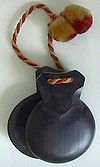Music of Castile and Leon
- Music of Castile and Leon
-
Central Spain includes the cultural melting pot of Madrid and Castile. A down-tempo version of jota is common, as well as other dances as fandango, habas verdes, 5/8 charrada. Bagpipes are still used in northern Leon and Zamora. Tabor pipe (in Leon) and dulzaina (shawm) enjoy rich repertoires. The city of Madrid is known for keeping its own version of chotis music. Salamanca is home to tuna, a form of serenade played on guitar, bandurria and tambourine, traditionally by students in medieval clothing.
Castilian dances include:
- Agudo
- Agudillo
- Charrada
- Fandango
- Jota
- Jotilla
- Habas verdes
- Rebolada
Leon is dominated by palatial dances that are extremely complex:
- Baile a lo Alto
- Baile del Pandero
- Danza de las Doncellas Cantadoras
- Danza de la Muerte
- El Corrido
- La Giraldilla
- Los Mandiles
- Zapateta
Categories: - Music of Spain by autonomous community
- Castilian music
- Music stubs
Wikimedia Foundation.
2010.
Look at other dictionaries:
Castile and León Day — Monolith to the Comuneros in Villalar Castile and León Day (Spanish: Día de Castilla y León) is a holiday celebrated on April 23 in the autonomous community of Castile and León, a subdivision of Spain. The date is the anniversary of the Battle of … Wikipedia
Music of Castile, Madrid and Leon — Central Spain includes the cultural melting pot of Madrid and Castile. A down tempo version of jota is common, as well as other dances as fandango, habas verdes, 5/8 charrada. Bagpipes are still used in northern Leon and Zamora. Tabor pipe (in… … Wikipedia
Music of Spain — The classical guitar originated from southern Spain The Music of Spain has a long history and has played an important part in the development of western music. It has had a particularly strong influence upon Latin American music. The music of… … Wikipedia
Castile (historical region) — A former kingdom, Castile ( es. Castilla, pronounced|kasˈt̪iʎa or IPA| [kasˈt̪iʝa] ), gradually merged with its neighbors to become the Crown of Castile and later the Kingdom of Spain. In modern day Spain, it is usually considered to comprise the … Wikipedia
Music of Galicia, Cantabria and Asturias — The traditional music of Galicia and Asturias, located along Spain s north west Atlantic coast, are highly distinctive folk styles that have some similarities with the neighbouring area of Cantabria. The music is characterized by the use of… … Wikipedia
Music of Andalusia — This article is about the music of Andalusia, Spain. For the style of music practiced in North Africa and the former Al Andalus, see Andalusian classical music. The Music of Andalusia is very diverse and includes many external influences such as… … Wikipedia
Music of Extremadura — Extremadura is a region in Spain near Portugal. Its folk music can be characterized by a melancholy sound, and Portuguese influences, as well as the predominance of the zambomba drum (similar to Brazilian cuica), which is played by pulling on a… … Wikipedia
Music of the Canary Islands — The music of the Canary Islands reflects its cultural heritage. The islands used to be inhabited by the Guanches which are related to Berbers; they mixed with Spaniards, who live on the islands now. A variant of Jota is popular, as is Latin music … Wikipedia
Music of Aragon — The music of Aragon, like its culture, has through history absorbed Roman, Celtic, Moorish and French influences. Traditional instruments include bagpipes, drums, flutes, tambourines, rattles and, perhaps most distinctively, the guitarro. Jota… … Wikipedia
Music of Murcia — Murcia is a region in the South East of Spain with many external influences varying from the ancient Moors that occupied the area for centuries to the adjacent Communities (Andalusia, Castilla La Mancha, etc.). Its music is determined by the… … Wikipedia

